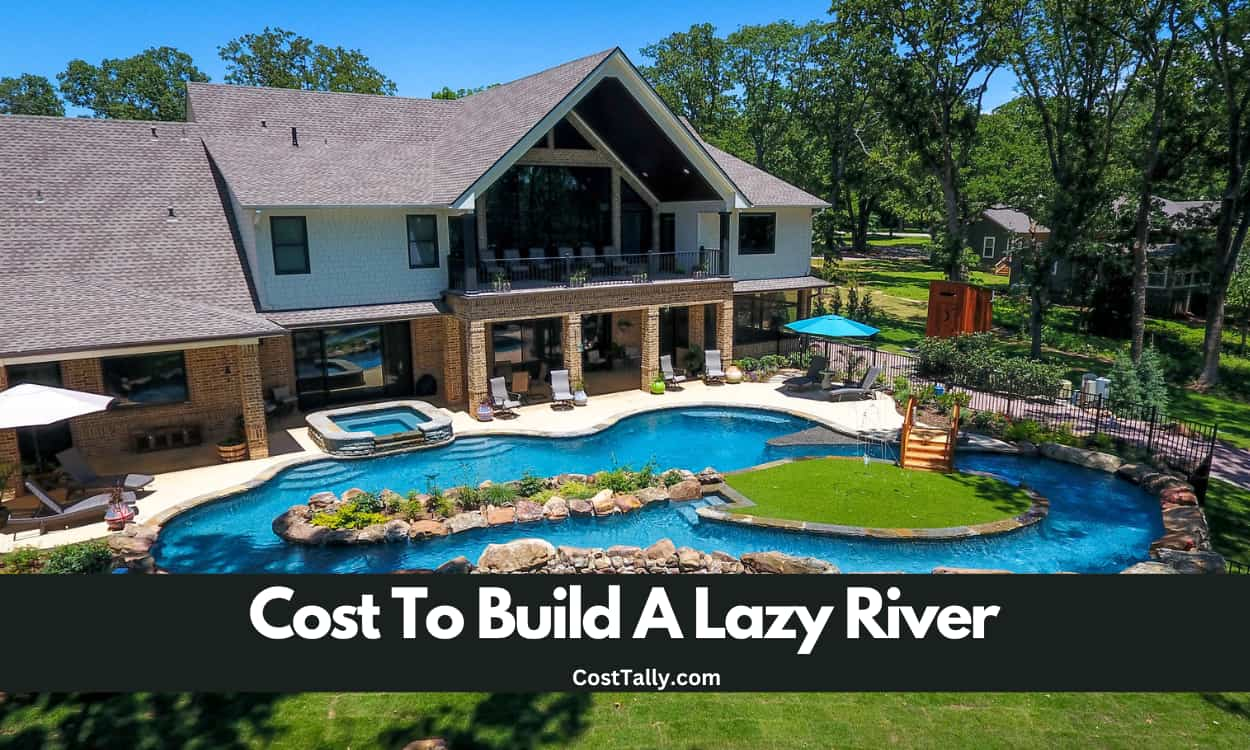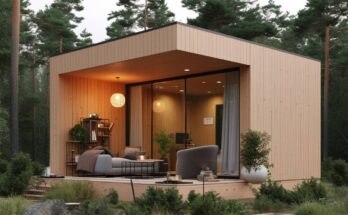Imagine stepping into your backyard on a hot summer day, not just to a typical pool, but to your very own lazy river.
A place where you can float peacefully, letting the gentle current carry you along. Sounds like a dream, right? Well, it’s a dream that more and more homeowners are turning into reality.
A backyard lazy river isn’t just a pool – it’s a statement. It’s a way to transform your outdoor space into a personal oasis, a place for relaxation and fun that goes beyond the ordinary.
But as with any major home improvement project, one of the first questions that comes to mind is: How much does it cost?
In this guide, we’ll dive deep into the world of backyard lazy rivers. We’ll explore what they are, how much they typically cost, the factors that influence those costs, and important considerations for building your own.
Whether you’re seriously considering adding a lazy river to your backyard or just daydreaming about the possibilities, this article will give you all the information you need.
So grab a cool drink, find a comfortable spot, and let’s float into the fascinating world of backyard lazy rivers!
How Much Does A Backyard Lazy River Cost?

What is a Backyard Lazy River?
Before we jump into costs, let’s make sure we’re all on the same page about what a backyard lazy river actually is.
Definition: A backyard lazy river is a water feature designed to mimic the experience of floating down a natural river, but in the comfort and privacy of your own property. It’s like a long, winding pool with a current that gently pushes you along.
Key Features:
- Curved shape: Unlike traditional rectangular pools, lazy rivers typically have a curved, meandering shape.
- Current: A pump system creates a gentle flow of water, allowing you to float along without effort.
- Entry and exit points: There are usually several spots where you can get in and out of the water.
- Varying depths: The depth can range from shallow areas for lounging to deeper sections for swimming.
Purpose: Lazy rivers serve multiple purposes:
- Relaxation: They provide a peaceful, stress-reducing environment.
- Exercise: You can swim against the current for a good workout.
- Entertainment: They’re great for parties and family fun.
- Aesthetic appeal: A well-designed lazy river can be a beautiful addition to your landscaping.
Comparison to Traditional Pools:
| Feature | Traditional Pool | Lazy River |
|---|---|---|
| Shape | Usually rectangular | Curved, winding |
| Water movement | Still | Flowing current |
| Purpose | Swimming, diving | Floating, relaxing |
| Space required | Varies, often less | Typically more |
| Cost | Generally lower | Usually higher |
Now that we understand what a backyard lazy river is, let’s dive into the big question: How much does it cost?
How Much Does One Have to Pay to Build a Lazy River?
When it comes to the cost of building a backyard lazy river, there’s no one-size-fits-all answer. The price can vary widely based on several factors. However, we can give you a general idea of what to expect.
Cost Range:
- Small, simple lazy rivers: $30,000 to $100,000
- Large, complex lazy rivers: Up to $500,000 or more
Cost per Linear Foot: A good rule of thumb is to budget between $120 and $150 per linear foot of the lazy river. This is just for the basic construction and doesn’t include extras like landscaping or special features.
Example Costs:
- A 50-foot lazy river might cost around $6,000 to $7,500
- A 100-foot lazy river could be in the range of $12,000 to $15,000
- A 400-foot lazy river (which would be quite large for a residential property) could cost $48,000 to $60,000 just for the basic construction
Important Note: These are just rough estimates. The actual cost of your lazy river could be higher or lower depending on various factors, which we’ll explore in the next section.
Factors That Influence the Cost of a Lazy River Project
The final price tag of your backyard lazy river will depend on several key factors. Understanding these can help you make informed decisions and potentially save money on your project.
1. Size and Length
- Bigger isn’t always better, but it is usually more expensive.
- Longer rivers require more materials and labor.
2. Shape and Design
- Simple oval shapes are less expensive than complex, winding designs.
- Custom shapes or themed designs will increase costs.
3. Depth
- Deeper rivers require more excavation and materials.
- Varying depths (for different purposes) can add to the cost.
4. Materials Used
- Concrete is typically cheaper than gunite or fiberglass.
- Higher-quality finishes (like custom tiles) will increase the price.
5. Location and Terrain
- Flat land is easier and cheaper to work with than sloped terrain.
- Your geographical location affects labor and material costs.
6. Features and Extras
- Basic lazy rivers are cheaper than those with added features.
- Waterfalls, bridges, or islands will increase the cost.
7. Pump System
- The type and power of the pump system affect both initial and ongoing costs.
- More powerful systems for faster currents are more expensive.
8. Landscaping
- The amount and type of landscaping around the lazy river impacts the overall cost.
- Natural-looking surroundings typically cost more than simple, grassy edges.
9. Permits and Regulations
- Costs for permits vary by location.
- Some areas may require additional safety features, adding to the cost.
10. Labor Costs
- These vary widely depending on your location and the complexity of the project.
- Specialized skills (like custom rockwork) will increase labor costs.
Cost Impact Table:
| Factor | Low Cost | High Cost |
|---|---|---|
| Size | Small (50-100 ft) | Large (300+ ft) |
| Shape | Simple oval | Complex, winding |
| Depth | Uniform, shallow | Varying, with deep areas |
| Materials | Concrete | Gunite or fiberglass |
| Terrain | Flat land | Sloped or rocky |
| Features | Basic river only | Waterfalls, bridges, islands |
| Pump System | Standard | High-power, multi-pump |
| Landscaping | Simple grass edges | Naturalistic rock and plantings |
Remember, while it’s tempting to cut costs, investing in quality materials and professional installation can save money in the long run by reducing maintenance needs and extending the life of your lazy river.
Building Your Lazy River
Now that we’ve covered the costs, let’s look at the process of actually building a backyard lazy river. This is a complex project that requires careful planning and professional expertise.
Steps in the Building Process:
- Planning and Design
- Work with a professional to create a design that fits your space and budget.
- Consider factors like sun exposure, views, and how the river will integrate with existing landscaping.
- Obtaining Permits
- Check local regulations and obtain necessary permits.
- This may involve submitting detailed plans to your local authorities.
- Site Preparation
- Clear the area and conduct any necessary grading.
- Mark out the exact shape and location of the lazy river.
- Excavation
- Dig out the path of the river.
- This is typically done with heavy machinery.
- Plumbing and Electrical Work
- Install the plumbing system for water circulation.
- Set up electrical connections for pumps and lighting.
- Structural Work
- Build the shell of the lazy river.
- This often involves spraying concrete (shotcrete) over a rebar framework.
- Finishing
- Apply the chosen finish (plaster, tile, etc.) to the river’s surface.
- Install any additional features like waterfalls or bridges.
- Pump Installation
- Set up the pump system that will create the river’s current.
- Landscaping
- Complete the surrounding landscaping to integrate the river into your yard.
- Filling and Testing
- Fill the river with water and test all systems.
Key Considerations:
- Size: Most experts recommend a minimum length of 50-60 feet for a good lazy river experience.
- Depth: A typical depth is around 3½ feet, but this can vary.
- Width: The river should be wide enough for comfortable floating, usually at least 5-6 feet.
- Current: The flow should be gentle enough for relaxation but strong enough to move you along.
Pump System:
- Lazy rivers typically use medium- or low-head pumps.
- These are strategically placed to create an even flow throughout the river.
- The number and power of pumps needed depend on the size and design of your river.
Construction Methods:
- The basic construction is similar to that of traditional pools.
- However, the curved shape and need for a current make lazy rivers more complex.
- Professional expertise is crucial for proper design and installation.
Remember, building a lazy river is not a DIY project. It requires specialized knowledge and skills to ensure safety, proper function, and longevity. Always work with experienced professionals who have a track record of successful lazy river installations.
What About Extra Costs?
When budgeting for a backyard lazy river, it’s crucial to look beyond just the initial construction costs. There are ongoing expenses that you’ll need to factor into your long-term financial planning.
Maintenance Costs:
- Monthly Expenses: Some homeowners report spending up to $1,000 per month on maintenance.
- What This Covers:
- Pump operation
- Pressure valve maintenance
- Water treatment (chlorine, etc.)
- Regular cleaning
- Minor repairs
Utility Costs:
- Electricity: Expect a significant increase in your electric bill due to constant pump operation.
- Water: Regular topping up of water levels and occasional draining and refilling will impact your water bill.
Chemical Costs:
- Chlorine and Other Treatments: Keeping the water clean and safe requires ongoing chemical treatments.
- Testing Supplies: Regular water testing is necessary to maintain proper chemical balance.
Equipment Replacement:
- Pumps: These may need replacement every 5-10 years, depending on quality and usage.
- Filters: Regular replacement of filter media or entire filter systems.
Seasonal Costs:
- Opening and Closing: If you live in an area with cold winters, you’ll need to properly close your lazy river in fall and reopen it in spring.
- Winter Maintenance: Even when not in use, some maintenance is required to prevent damage from freezing.
Repair Costs:
- Surface Repairs: Cracks or damage to the river’s surface may need periodic attention.
- Plumbing Repairs: Leaks or issues with the circulation system can be costly to fix.
Insurance:
- Increased Premiums: Your homeowner’s insurance rates may go up with the addition of a lazy river.
- Additional Coverage: You might need extra liability coverage.
Professional Services:
- Regular Inspections: Having a professional check your system periodically can prevent costly breakdowns.
- Cleaning Services: Many homeowners opt for professional cleaning services, especially for larger rivers.
Cost Comparison Table:
| Expense Type | Estimated Annual Cost |
|---|---|
| Monthly Maintenance | $6,000 – $12,000 |
| Electricity | $1,200 – $3,600 |
| Water | $500 – $1,500 |
| Chemicals | $500 – $1,000 |
| Equipment Replacement Fund | $1,000 – $2,000 |
| Seasonal Opening/Closing | $500 – $1,000 |
| Insurance Increase | $200 – $500 |
| Professional Services | $1,000 – $2,000 |
Total Estimated Annual Extra Costs: $10,900 – $23,600
These figures are rough estimates and can vary widely based on your specific situation, the size of your lazy river, local costs, and how much maintenance you’re willing to do yourself. It’s always best to get detailed estimates from local professionals for the most accurate picture of ongoing costs in your area.
Other Important Things to Consider
Beyond the financial aspects, there are several other important factors to consider before embarking on a backyard lazy river project:
1. Space Requirements
- Yard Size: Ensure your yard is large enough to accommodate a lazy river without feeling cramped.
- Zoning Laws: Check local regulations regarding the percentage of your property that can be covered by water features.
2. Safety Considerations
- Fencing: Many areas require fencing around water features for safety.
- Depth Markers: Clearly mark water depths to prevent accidents.
- Non-Slip Surfaces: Use appropriate materials to prevent slips and falls around the river.
- Life-Saving Equipment: Keep flotation devices and first aid kits easily accessible.
3. Environmental Impact
- Water Usage: Consider the environmental impact of water consumption, especially in drought-prone areas.
- Energy Consumption: Look into energy-efficient pump systems to reduce your carbon footprint.
- Chemical Use: Research eco-friendly water treatment options.
4. Resale Value
- Positive Impact: A well-designed lazy river can significantly increase property value.
- Potential Drawback: Some buyers might see it as a maintenance burden, potentially limiting your buyer pool.
5. Lifestyle Fit
- Usage: Consider how often you’ll actually use the lazy river to justify the investment.
- Maintenance Time: Be honest about whether you’re willing to commit to the necessary upkeep.
6. Climate Considerations
- Year-Round Use: In colder climates, you may only be able to use the river for a few months each year.
- Heating Options: Consider the cost and practicality of heating the water for extended use.
7. Accessibility
- Entry and Exit Points: Ensure easy access for all family members, including those with mobility issues.
- Surrounding Area: Plan for comfortable seating and shaded areas around the river.
8. Noise Levels
- Pump Noise: Consider the location of pump equipment to minimize noise disturbance.
- Neighbor Considerations: Think about how increased outdoor activity might affect your neighbors.
9. Lighting and Aesthetics
- Night-Time Use: Plan for appropriate lighting for safety and ambiance.
- Visual Appeal: Consider how the river will look from inside your home and from different points in your yard.
10. Future Plans
- Family Changes: Will the lazy river still suit your needs as your family grows or changes?
- Long-Term Commitment: Are you planning to stay in your home long enough to enjoy the investment?
Choosing a Contractor:
- Experience: Look for contractors with specific experience in lazy river construction.
- References: Ask for and check references from previous lazy river projects.
- Licensing and Insurance: Ensure the contractor is properly licensed and insured.
- Detailed Contract: Get a comprehensive contract that covers all aspects of the project, including timelines and payment schedules.
Questions to Ask Your Contractor:
- How many lazy rivers have you built?
- Can you provide references from previous lazy river clients?
- What type of warranty do you offer on your work?
- How long will the project take from start to finish?
- Will you handle all necessary permits and inspections?
- What type of ongoing maintenance will the lazy river require?
- Can you provide a detailed breakdown of all costs involved?
- What challenges do you foresee with my specific property?
- How will you ensure the safety of the lazy river?
- What energy-efficient options can you offer for the pump system?
By carefully considering these factors and asking the right questions, you can ensure that your backyard lazy river project is a success, providing years of enjoyment for you and your family.
Conclusion
A backyard lazy river is more than just a pool – it’s a transformative addition to your home that can provide endless hours of relaxation, fun, and even exercise. From the gentle current that carries you along to the soothing sound of flowing water, a lazy river can turn your backyard into a personal resort.
However, as we’ve explored in this guide, building a lazy river is a significant undertaking. It requires careful planning, a substantial financial investment, and ongoing commitment to maintenance and care. The costs can range from tens of thousands to hundreds of thousands of dollars, depending on the size, complexity, and features of your design.
Key takeaways to remember:
- Costs vary widely: From $30,000 for a simple design to $500,000 or more for larger, more complex rivers.
- Ongoing expenses: Budget for significant monthly maintenance costs, increased utility bills, and periodic repairs.
- Professional expertise is crucial: This is not a DIY project – you’ll need experienced contractors.
- Consider all factors: Space requirements, safety, environmental impact, and lifestyle fit are all important considerations.
- Plan for the long term: Think about how a lazy river fits into your future plans for your home and family.



